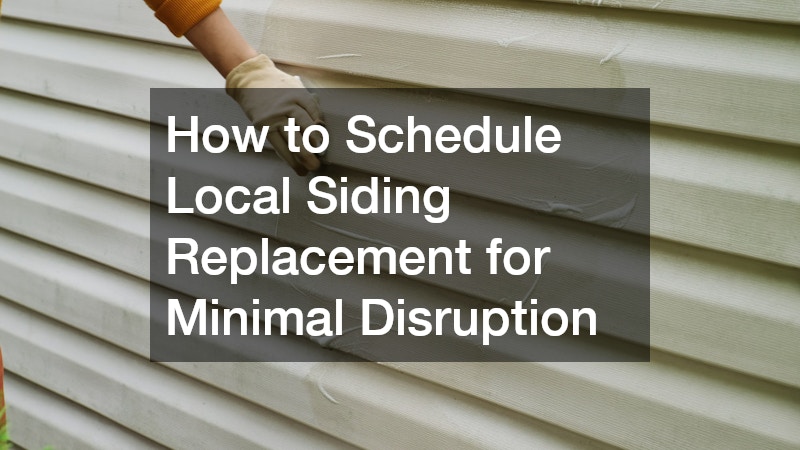In this article, we will explore effective strategies for scheduling local siding replacement to ensure minimal disruption to your daily life. Understanding key considerations and planning accordingly can make the process smoother and less intrusive.
What is the Best Time of Year for Siding Replacement?
Choosing the right time of year for siding replacement is essential for minimizing disruption. Each season presents its unique weather patterns, which can affect the efficiency of installation.
Spring and fall are often considered the best seasons due to mild temperatures, lower humidity, and reduced precipitation.
Scheduling your project during these ideal months can lead to quicker completion times. Moreover, contractors tend to have more flexible schedules during these off-peak seasons, possibly allowing for more favorable pricing. Being aware of local climate trends can guide your decision on when to undertake this major home improvement.
In addition to weather considerations, it’s a good idea to take into account any local seasonal events or holidays that could affect your neighborhood’s overall activity. Planning your siding replacement project during a quieter time can help keep both your household and your neighbors’ daily routines uninterrupted.
How Can I Coordinate with My Contractor for a Smooth Process?
Effective communication with your contractor is key to scheduling your siding replacement project smoothly. Start by discussing your timeline and any specific requirements that you may have. Clarifying expectations upfront can lead to better cooperation and adherence to the agreed schedule.
It’s beneficial to establish a point of contact—whether that be the project manager or the contractor themselves—who will keep you updated throughout the process. Regular check-ins and updates will ensure that you’re informed about progress, potential delays, and other essential elements of the project.
Finally, be open to feedback from your contractor regarding the best practices for scheduling and execution. Their experience will be invaluable in guiding you through not just the installation but also adjusting your plan as necessary based on your home’s specific needs.
What Should I Communicate to My Neighbors About the Siding Project?
Before starting your siding replacement, it’s considerate to inform your neighbors well in advance. A simple announcement, whether in person or via a note, can help set expectations about noise and disruption. Let them know the estimated timeline for the work, so they can plan accordingly.
Additionally, addressing potential concerns or questions they may have can foster goodwill and a respectful neighborhood relationship. This can be particularly useful if you share common boundaries or if their property will be affected by the work.
By proactively communicating with your neighbors, you can mitigate misunderstandings and resistance to the project, leading to a more harmonious atmosphere during your siding replacement. Effective neighborly diplomacy can provide a smoother overall experience for you and the surrounding community.
What Preparations Should I Make Inside My Home Before the Work Begins?
Preparing your home is critical to ensuring minimal disruptions during the siding replacement project. Start by moving any delicate or valuable items away from exterior walls to protect them from dust, debris, and potential damage. This applies to both indoor decorations and outdoor furniture.
Consider designating a specific space for the contractor’s materials and equipment. This can help organize the work area and keep your home cleaner. Providing space will also enable workers to go in and out more freely without interfering with your daily life.
Lastly, it’s advisable to plan for temporary accommodations or adjust your schedule. Depending on the scope of the work, certain areas in your home might be too noisy or chaotic for regular activities. Preparing ahead allows you to maintain some semblance of daily routine amidst the renovations.
What Steps Can I Take to Minimize Noise and Disruption During the Project?
Noise is an unavoidable part of any construction project, but there are steps you can take to limit its effect on your daily life. First, schedule the most noisy work for specific hours when it’s least disruptive. Discussing your concerns with your contractor can help identify quieter options for tasks that may take place during the day.
Another effective strategy is to create a temporary living space in a quieter part of your home. Designating rooms away from the construction site for work, rest, or leisure can help you carry on with your everyday activities while the siding replacement is occurring.
Lastly, consider using noise-canceling headphones or earplugs for a more peaceful atmosphere. Establishing a quieter environment can allow you some reprieve from the unavoidable construction noise, particularly during crucial or higher-impact phases of the project.
By following the tips outlined above, homeowners can effectively schedule their siding replacement to minimize disruption. Careful planning and clear communication with your contractors will not only make the process smoother but also help prevent unexpected delays or issues. Taking the time to prepare, ask the right questions, and understand the scope of the project ensures a more efficient and stress-free experience, ultimately leading to a beautiful, long-lasting result for your home.



